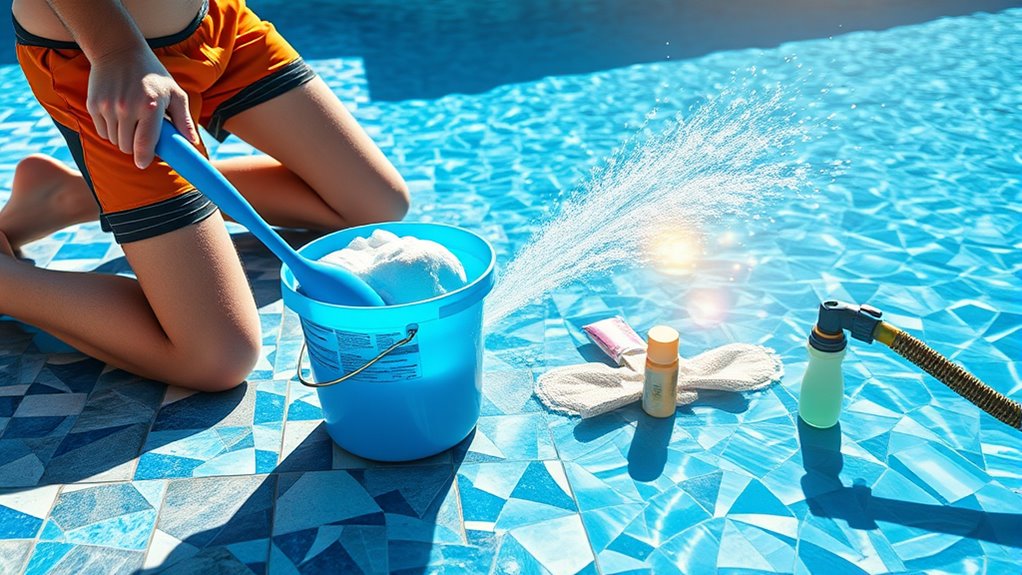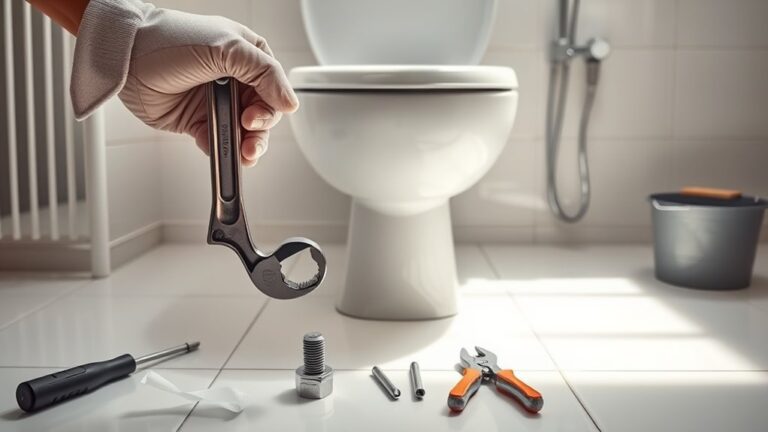To get rid of stains on your pool floor, first identify the stain type—metal, organic, or calcium—and choose the appropriate cleaner. Partially drain the pool to access stains easily. Apply the stain remover based on your pool’s surface and scrub with a suitable brush. For tough stains, use a pumice stone or specialized rust cleaner. Afterward, balance your pool chemistry to prevent future stains. Following these steps will help you understand how to keep your pool floor clean and stain-free efficiently.
Identifying the Type of Stain on Your Pool Floor
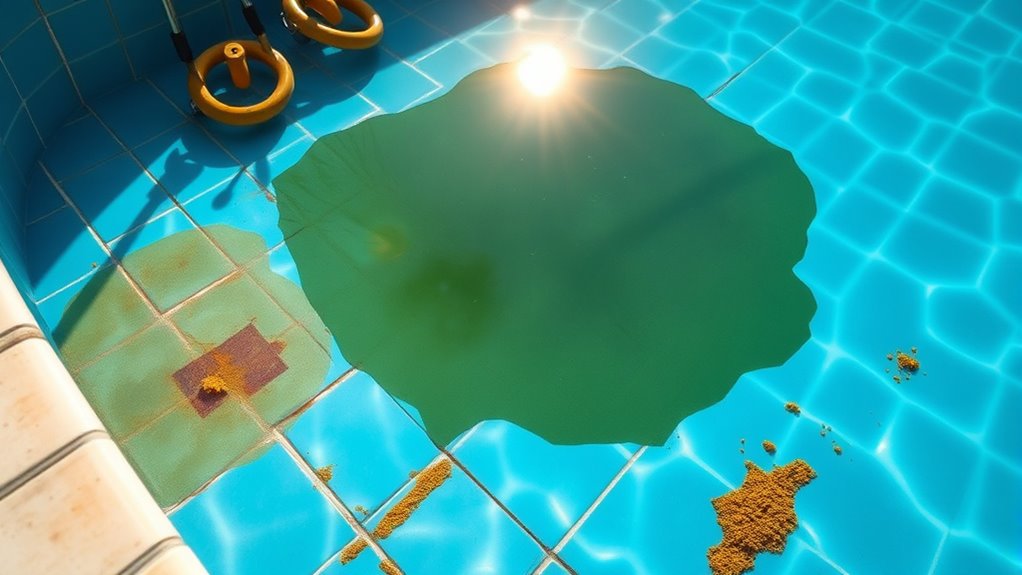
How can you effectively remove stains if you don’t first identify their type? Accurate stain identification is essential to selecting the appropriate treatment method. Begin by examining the discoloration’s color, texture, and location on the pool floor. Common stain types include metal stains (often green, brown, or black), organic stains (usually dark brown or black), and calcium deposits (white or light-colored). Use a stain identification guide or test kits to differentiate between these categories. For instance, metal stains typically react to acid-based cleaners, while organic stains require enzymatic or oxidizing agents. Understanding each stain type’s chemical composition empowers you to address the problem efficiently, avoiding trial-and-error approaches that waste time and resources. Mastering stain identification grants you the freedom to restore your pool floor with confidence and precision.
Gathering Necessary Cleaning Supplies and Tools
You’ll need specific cleaning materials like pool stain remover, a pH balancer, and a non-abrasive scrub brush to tackle stains effectively. Make certain to have tools such as a pool vacuum and a telescopic pole for reaching all areas. Gathering these supplies before starting guarantees a smooth and efficient cleaning process.
Essential Cleaning Materials
A well-equipped toolkit is essential for effectively removing stains from your pool floor. Start by selecting appropriate cleaning agents designed specifically for pool surfaces. These agents should target common stains like algae, rust, or calcium deposits without damaging the floor material. Next, choose stain removers formulated for the type of stain you’re dealing with; for example, chelating agents work well on metal stains, while enzymatic cleaners excel against organic matter. Make certain you have pH-neutral or balanced products to maintain water chemistry stability. Always read product instructions carefully to avoid adverse reactions. By equipping yourself with the right cleaning agents and stain removers, you’ll gain the freedom to tackle pool floor stains efficiently, restoring your pool’s appearance and extending its lifespan.
Recommended Cleaning Tools
Three essential tools you’ll need for effective stain removal on your pool floor include a pool brush, a vacuum system, and a telescoping pole. The pool brush, preferably stainless steel for concrete surfaces or nylon for vinyl, helps loosen stubborn stains. Attach the brush to the telescoping pole for extended reach and precise control. Next, a high-quality vacuum system is vital; it efficiently removes dislodged debris and prevents stains from settling. Mastering pool vacuuming techniques guarantees thorough cleaning without damaging your pool surface. Additionally, consider a chemical feeder or stain remover compatible with your pool type. Combining these tools with regular stain prevention methods, like balanced water chemistry and prompt debris removal, will maintain your pool floor’s pristine condition and grant you the freedom to enjoy a spotless swimming environment.
Draining Part of the Pool for Easier Access
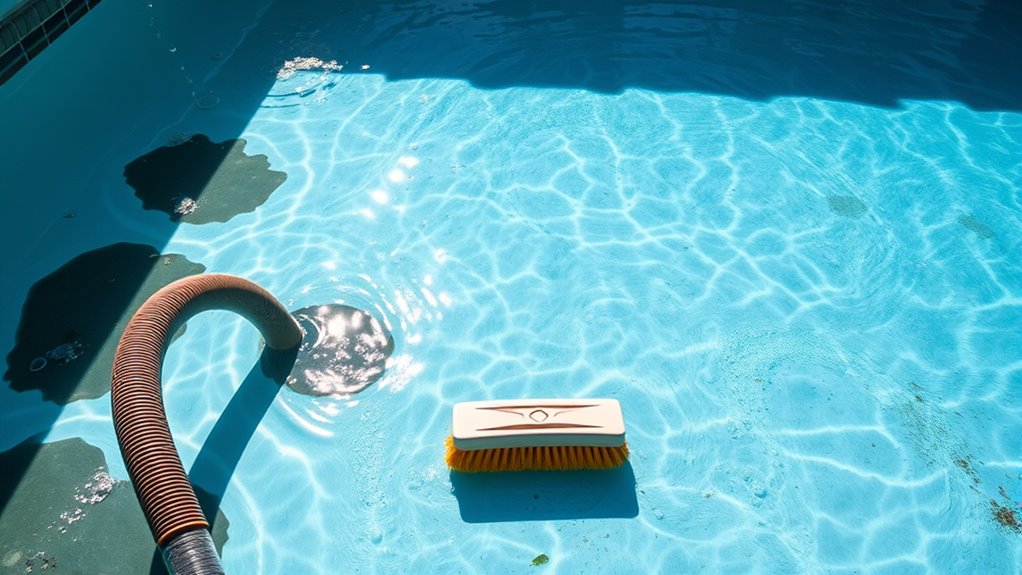
You’ll want to partially drain your pool to lower the water level and gain better access to stained areas on the floor. Make sure to maintain a safe water level to avoid damaging the pool structure or equipment. Use a submersible pump or the pool’s built-in drain valve to control the draining process efficiently.
Reasons to Partially Drain
Although fully draining the pool can be time-consuming and disruptive, partially draining it provides easier access to stubborn stains on the floor without compromising the overall water balance. This targeted approach offers several drainage benefits: it reduces the effort and time needed for complete water removal, lessens chemical rebalancing requirements, and minimizes the risk of structural damage. By preserving most of the pool’s water, you maintain the pool’s ecosystem, cutting down on water waste and chemical costs. Partial drainage also allows you to focus cleaning on problem areas without interrupting regular pool use, giving you greater freedom and control over maintenance. In short, partial draining balances effective stain removal with efficient water preservation, making it the smart choice for routine pool care.
Safe Water Level Tips
Maintaining a safe water level when draining part of your pool is essential to prevent damage and guarantee effective stain removal. Lower the water enough to expose the stained area without fully emptying the pool, as this can cause structural stress. Monitor the water level carefully; it should remain above the main drain to avoid air entering the filtration system. Always adhere to safety precautions by ensuring electrical equipment is unplugged and the pool deck is dry to prevent slips. Use barriers to restrict access during draining. Check local regulations regarding water discharge to avoid environmental issues. By controlling the water level precisely, you’ll gain easier access for stain treatment while preserving your pool’s integrity and keeping safety top priority throughout the process.
Tools for Controlled Draining
Three essential tools make controlled draining of your pool efficient and safe: a submersible pump, a garden hose, and a water level indicator. Start by placing the submersible pump at the lowest pool point to remove water steadily without damaging surfaces. Connect the garden hose to direct water away from your property, preventing erosion or flooding. Use the water level indicator to monitor depth continuously, ensuring you only drain the necessary amount. Applying controlled drainage techniques helps maintain pool integrity while giving you easier access to stains on the floor. Always follow safe draining methods by avoiding over-draining, which can stress pool walls. These tools and techniques combine to give you precise, manageable water removal, preserving your pool’s structure and simplifying stain removal tasks.
Applying a Stain Remover Suitable for Your Pool Material
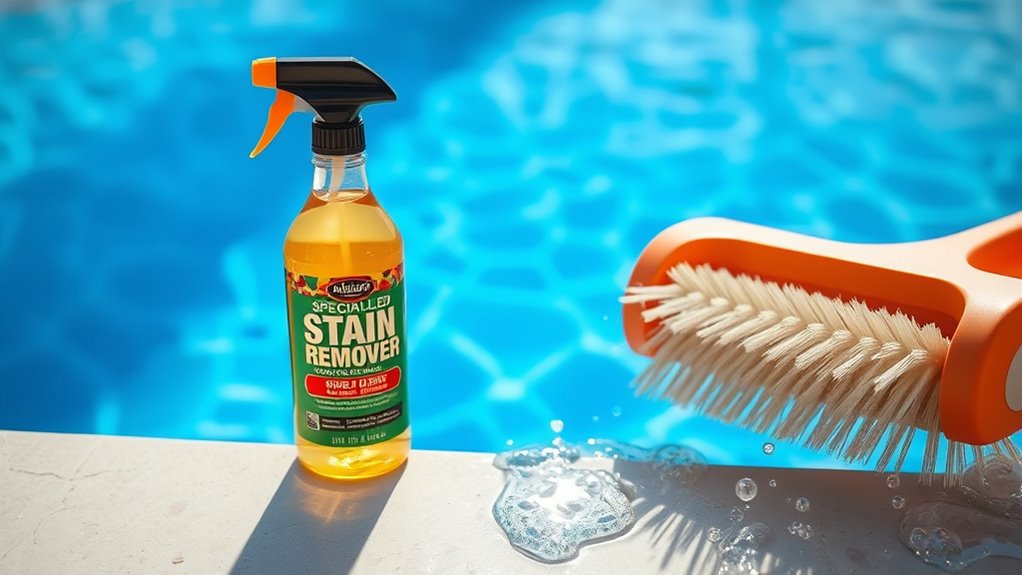
Selecting the right stain remover depends on your pool’s surface material, whether it’s concrete, fiberglass, or vinyl. Different stain remover types are formulated to target specific stains while preserving your pool’s integrity. For concrete pools, use acid-based removers designed to dissolve mineral deposits without etching the surface. Fiberglass pools require gel-based or non-acidic stain removers that won’t degrade the gel coat. Vinyl pools need gentle, non-abrasive solutions that prevent weakening of the liner. Always verify pool material compatibility on the product label before application. Apply the stain remover directly to the affected area, following manufacturer instructions precisely. Confirm even coverage and avoid over-application to prevent damage. Proper selection and application of stain removers will maximize stain removal efficiency while keeping your pool surface intact.
Scrubbing the Stained Areas With a Pool Brush
After applying the stain remover, you’ll need to scrub the affected areas to break up and lift the stain from the pool floor. Use a stiff-bristled pool brush designed for your pool’s surface material to guarantee effective scrubbing. Employ circular motions with moderate pressure, focusing on stained spots without damaging the pool finish. Start from the outer edges of the stain and work inward, loosening debris and residue. Maintain consistent brushing speed and angle to maximize stain removal while conserving effort. Rinse the brush frequently to avoid redepositing loosened particles. Mastering these pool brush techniques empowers you to regain a pristine pool floor quickly and efficiently, giving you the freedom to enjoy your pool without unsightly stains holding you back.
Using a Pumice Stone for Tougher Stains
When stubborn stains resist brushing, using a pumice stone can provide the extra abrasion needed to lift them from the pool floor. The pumice stone benefits include its abrasive texture that effectively scrapes off tough stains without damaging the pool surface. Before using it, wet both the stone and the stained area to prevent scratching. Apply moderate pressure and move the pumice stone in circular motions over the stain. This method guarantees effective stain removal while preserving your pool’s finish. Avoid using excessive force, as it might cause surface wear. After treatment, rinse the area thoroughly to remove residue. Incorporating a pumice stone into your cleaning routine gives you greater control over stubborn stains, helping maintain a pristine pool floor with minimal effort.
Treating Rust Stains With a Specialized Cleaner
While pumice stones work well for many stains, rust marks require a different approach due to their chemical composition. To effectively treat a rust stain, start by selecting a specialized cleaner designed specifically for iron and metal oxidation. These cleaners contain chelating agents that break down rust without damaging your pool surface. Before application, verify the pool is partially drained or the area is dry to maximize cleaner contact. Apply the specialized cleaner directly onto the rust stain, following the manufacturer’s instructions precisely. Allow it to sit for the recommended time to dissolve the rust. Then, scrub gently with a soft brush and rinse thoroughly. Repeat if necessary. Using a specialized cleaner guarantees you remove rust stains efficiently while preserving your pool floor’s integrity.
Balancing Pool Chemistry to Prevent Future Stains
Since untreated water chemistry can accelerate stain formation, maintaining balanced pool chemistry is essential to prevent future discoloration on your pool floor. Achieving proper chemical balance not only safeguards your pool’s surfaces but also enhances your swimming experience. Follow these steps for effective stain prevention:
Balanced pool chemistry is key to preventing stains and protecting your pool’s surfaces.
- Test your pool water weekly for pH, alkalinity, calcium hardness, and chlorine levels.
- Adjust pH to stay between 7.2 and 7.6 to prevent corrosive or scaling conditions.
- Maintain total alkalinity within 80-120 ppm to buffer pH changes and stabilize chemical balance.
- Keep calcium hardness between 200-400 ppm to avoid scaling and metal staining.
Regular Maintenance Tips to Keep Your Pool Floor Stain-Free
Three key maintenance tasks can greatly reduce the risk of stains forming on your pool floor. First, establish a consistent maintenance schedule that includes weekly brushing of the pool floor to prevent algae and mineral buildup. Second, regularly test and adjust your pool’s chemical levels—pH, alkalinity, and calcium hardness—to ideal ranges, which serve as critical preventive measures against staining. Third, promptly remove debris such as leaves and dirt using a pool vacuum or skimmer to minimize organic contaminants. Adhering to these tasks prevents stains by controlling the environment that fosters their development. Consistency in these preventive measures not only keeps your pool floor stain-free but also extends the life of your pool surfaces, giving you the freedom to enjoy a clear, clean swimming environment without frequent intensive cleaning sessions.

